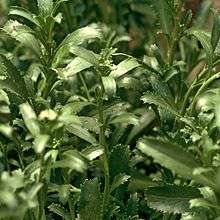Lepidium banksii
Lepidium banksii, known as coastal peppercress, is a rare species of flowering plant from the family Brassicaceae. It is endemic to New Zealand, formerly found around the coast of the northern South Island but now critically endangered.[4][5]
| Lepidium banksii | |
|---|---|
 | |
| Coastal peppercress | |
| Scientific classification | |
| Kingdom: | Plantae |
| Clade: | Tracheophytes |
| Clade: | Angiosperms |
| Clade: | Eudicots |
| Clade: | Rosids |
| Order: | Brassicales |
| Family: | Brassicaceae |
| Genus: | Lepidium |
| Species: | L. banksii |
| Binomial name | |
| Lepidium banksii | |
| Synonyms[3] | |
|
Lepidium forsteri | |
Discovery
Coastal peppercress was first collected for culinary purposes: by Cook, in 1770 in the Marlborough Sounds, along with its relative Lepidium oleraceum, as a treatment for scurvy. Both species are members of the Brassicaceae or cabbage family and contain vitamin C.[6] It was collected again in 1827 by Dumont d'Urville in Queen Charlotte Sound and Astrolabe Harbour (now in Abel Tasman National Park), and from those specimens was described by Thomas Kirk in 1899[7] and named after Sir Joseph Banks, the naturalist on Cook's first voyage.[3]
Description
Coastal peppercress is a low rambling fleshy-leaved coastal herb. It resembles the closely related Cook's scurvy grass or nau (L. oleraceum), but is darker in colour and with more deeply toothed leaves. Its seed pods are much larger and deeply notched, and it each winter it dies back to its rootstock.[8]
Distribution
Lepidium banksii is strictly coastal, growing in boulder banks and on shell banks in estuaries. Formerly it was found in the northern South Island, from Karamea on the West Coast to Tasman and Golden Bays and the Marlborough Sounds, but by the 1950s had grown so scarce that Allan writing the Flora of New Zealand series was unable to refer to a recent specimen.
In 1988, Phil Garnock-Jones was revising the New Zealand Lepidium species, and realised that L. oleraceum specimens collected in 1961 near Totoranui in Abel Tasman National Park were actually L. banksii.[8] Field surveys revealed the plant was still there. It was also discovered in the Waimea Estuary near Nelson during a survey by DOC botanist Shannel Courtney.[3]
Conservation
Lepidium banksii is the rarest of New Zealand's 11 Lepidium species.[1] By 1991 only 22 plants were known in the wild. In 1994, a new population of about 450 was discovered in a remote cove in Abel Tasman National Park, but soon after these were all destroyed by feral pigs. The species is very vulnerable to pests and diseases, and proved to be extremely difficult to cultivate and successfully replant in the wild.[4] A new strategy of sowing seed directly in guano-rich soils where seabirds congregated proved more fruitful, and by the mid 2000s hundreds of plants were successfully established and self-seeding.[8] L. banksii was functionally extinct in the wild, and its entire population continues to rely on ongoing artificial propagation efforts.
References
- de Lange, P. J.; Norton, D. A.; Courtney, S. P.; Heenan, P. B.; Barkla, J. W.; Cameron, E. K.; Hitchmough, R.; Townsend, A. J. (2009). "Threatened and uncommon plants of New Zealand (2008 revision)". New Zealand Journal of Botany. 47 (1): 61–96. doi:10.1080/00288250909509794. ISSN 0028-825X.
- "Lepidium banksii Kirk". www.theplantlist.org. The Plant List. Retrieved 18 May 2016.
- de Lange, P.J. (21 August 2013). "Lepidium banksii". New Zealand Plant Conservation Network. Retrieved 18 May 2016.
- de Lange, Peter; Heenan, Peter; Houliston, Gary; Rolfe, Jeremy; Mitchell, Anthony (17 June 2013). "New Lepidium (Brassicaceae) from New Zealand". PhytoKeys. 24 (24): 1–147. doi:10.3897/phytokeys.24.4375. PMC 3689132. PMID 23794938.
- Gee, Samantha (17 May 2016). "Dunedin climate could be key to survival of critically endangered Nelson plant". Fairfax Media Digital. Nelson Evening Mail. Retrieved 18 May 2016.
- Phillips, Vanessa (20 March 2009). "Defying a 'death wish'". Nelson Mail. Retrieved 18 May 2016.
- Kirk, Thomas (1899). The students' flora of New Zealand and the outlying islands. Wellington, New Zealand: John Mackay. p. 35. doi:10.5962/bhl.title.54373. Retrieved 18 May 2016.
- De Lange, Peter; Heenan, Peter (Sep–Oct 2006). "Unsung heroes". New Zealand Geographic.
External links
- Lepidium banksii on RNZ Critter of the Week, 20 May 2016
